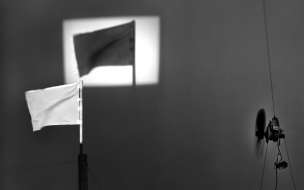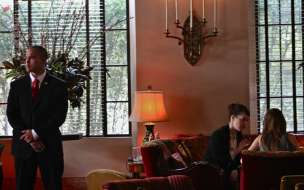Exhibitions: False Flags
“False Flags” is on view April 1 – May 29, 2016, at Pelican Bomb Gallery X and includes work by nine artists addressing nationalism and the representation of imagined communities.

Pelican Bomb is proud to present “False Flags,” a group exhibition curated by Noah Simblist and produced by Amanda Brinkman. It features nine artists from around the world whose practices investigate contemporary notions of nationalism and the representation of imagined communities in the Middle East and the Americas. The term “false flag” is derived from a historical practice of naval warfare by which nations would fly colors other than their own to deceive an enemy. In modern times, the term has been used to describe a covert military operation designed to appear as if carried out by another entity. But a false flag assumes that a true flag is, in fact, real—more than a symbolic object or set of abstract signs.
Most often we think of flags in relation to nations. Political scientist Benedict Anderson famously called a nation an “imagined community,” a concept that is complicated when we think of states in waiting, like the Palestinian Authority, or refugee camps that exist outside of nationalism entirely. Flags can signal territorial and extraterritorial conditions, but they can also signal revolutionary struggles and their failures. The artists in “False Flags” probe these multiple meanings through a range of media including painting, sculpture, video, and performance.
In his painting Conquest (Ice Shelf), 2012, William Binnie depicts an arctic vista, questioning the perception of landscapes as virgin territories and the use of flags as a mechanism to assert ownership. This practice of physically and culturally staking claim to the natural world is echoed in Israeli artist Ariel Reichman’s installation Blowing in the Wind, 2009. The artist reimagines the colonizing gesture as a pathetic act (Reichman’s makeshift flag waves in the light of a slide projector). Rona Yefman’s video 2 Flags, The last battle of the Stripes and the Hoods, 2004-06, envisions a game of Capture the Flag as an allegory for the gamesmanship of warfare. This sardonic sense of play is echoed in a video work by Nicolás Guagnini, which documents a performative walk through New York City with a large transparent flag.
Other artists in “False Flags” use their practices to subvert the very idea of nationalities and borders. Exterritory Project’s video Flags of Convenience, 2016, commissioned by Pelican Bomb for this exhibition, points to practices of transnational corporations that use national flags to evade legal frameworks for both taxes and human rights. Tania Bruguera’s The Francis Effect, which debuted at the Guggenheim Museum in New York in 2014, a performance in the guise of a political campaign, requests that the Pope grant Vatican citizenship to all immigrants and refugees and uses Pangea—a prehistoric supercontinent—as its logo. Together, these two works demand that stateless peoples also have the rights that transnational corporations enjoy. In a newly commissioned work, Minerva Cuevas riffs on the symbolism of the Olympics, examining the ways in which Mexico City became a site for both pageantry and protest during the 1968 games.
Both Public Movement and Jamal Cyrus question how we collectively imagine communities and public histories. Public Movement’s Debriefing Session I—first performed in the 2012 New Museum Triennial—maps out the complexities of Israeli and Palestinian nationalism, as alternately defined by Palestinian solidarity and the Jewish diaspora. In two works on view, Cyrus investigates the relationship between individuals and cultures at large, drawing from an archive of African-American political and cultural history that includes abolitionist John Brown, the Black Panthers, and Blaxploitation films.
In presenting “False Flags” in New Orleans, Pelican Bomb aims to situate the city’s contemporary negotiations around ownership, contested lands, and cultural identity within global conversations surrounding nationalism and representation. At Pelican Bomb Gallery X, the works on view carry additional resonance with the city’s distinct pageantry traditions and its unique position at the historic intersection of Europe and the Global South. Over the course of the exhibition, Pelican Bomb’s online Art Review will publish essays, interviews, and artist projects, adding additional voices and points of reference beyond the gallery walls.
Pelican Bomb Gallery X is free and open to the public Wednesday - Sunday, 12 - 5 pm. Admission is free.
Noah Simblist is Associate Professor and Chair of the Division of Art at Southern Methodist University’s Meadows School of the Arts in Dallas, Texas. In 2014, Pelican Bomb brought Simblist to New Orleans as part of the organization’s Critic-in-Residence program.
Generous support for “False Flags” is provided by Artis, Prospect New Orleans, the Joan Mitchell Center, and the International House Hotel.
Contact Charlie Tatum at 504.252.0136 or charlie@pelicanbomb.com with all press inquiries.
“False Flags”
Pelican Bomb presents a group exhibition that investigates contemporary notions of nationalism and the representation of imagined communities.

Opening Reception: “False Flags”
Join us for the opening of a new group exhibition at Pelican Bomb Gallery X.

Panel Discussion: “Imagined Communities and the Nation State”
Join “False Flags” curator Noah Simblist for a talk at Tulane University.

Public Movement’s “Debriefing Session I”
Public Movement brings their action “Debriefing Session I” to New Orleans.

Artist Talk: Tania Bruguera
In conjunction with “False Flags,” Pelican Bomb presents a lecture by internationally renowned artist Tania Bruguera.

